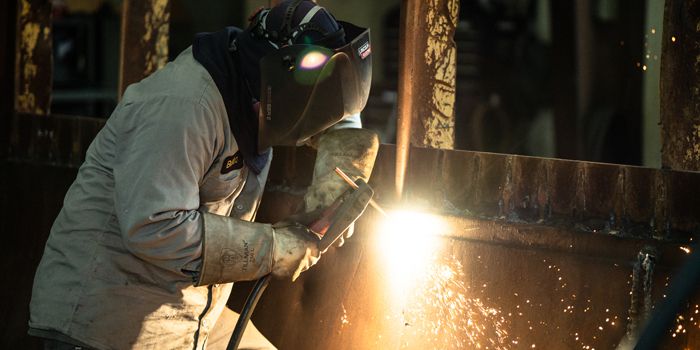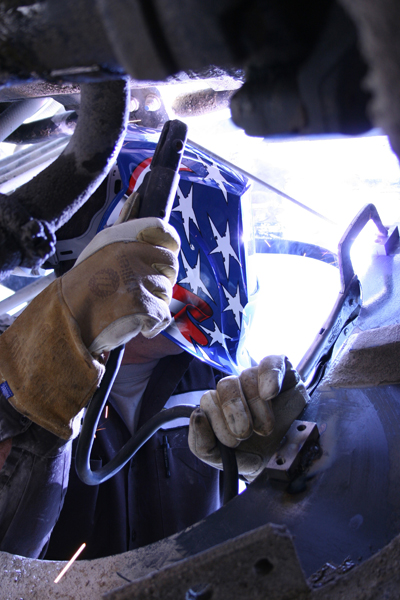Usual Welding Repair Service Issues and Just How to Address Them Properly
Welding fixings frequently encounter a series of problems that can threaten the integrity of the end product. Common problems consist of inadequate penetration, porosity, and misalignment, amongst others. Each problem presents distinct obstacles that need particular approaches for resolution. Comprehending these concerns is vital for welders aiming to boost their results and abilities. This conversation will check out these typical welding repair work issues and effective techniques to resolve them.
Inadequate Infiltration
Poor infiltration takes place when the weld metal fails to totally fuse with the base material, resulting in weak joints and possible architectural failures. This issue often comes from inadequate warmth input, wrong electrode angle, or improper welding rate. Welders may run into poor penetration as a result of a mistake of the needed criteria for a specific product density or kind. In addition, contamination on the base product's surface area can hinder effective bonding, aggravating the issue. To deal with inadequate penetration, welders need to guarantee suitable settings on their devices and keep a clean work surface area. Regular inspection of welds is suggested to determine any deficiencies early, allowing for timely adjustments and the avoidance of endangered structural integrity in bonded settings up.
Porosity
Porosity is an usual flaw in bonded joints that shows up as small gas bubbles trapped within the weld metal. This defect can jeopardize the integrity of the weld, leading to lowered toughness and potential failing under anxiety. Montana Mobile Welding and Repair Welding. Porosity commonly emerges from contamination, moisture, or inappropriate welding techniques, which allow gases to escape into the molten weld pool. To deal with porosity, welders should ensure correct surface prep work, preserve a clean workplace, and make use of ideal welding specifications. Additionally, selecting the best filler product and shielding gas can mitigate gas entrapment. Normal evaluation and testing of welds can assist identify porosity early, assuring timely rehabilitative activities are taken, therefore preserving the quality and integrity of the welded structure
Imbalance
Misalignment in welding can emerge from various factors, consisting of incorrect arrangement and thermal expansion. Comprehending the origin is vital for reliable resolution. A number of improvement techniques are available to realign elements and guarantee structural honesty.
Reasons for Imbalance
Welding misalignment often originates from a variety of underlying problems that can compromise structural integrity. One main cause is incorrect fit-up of components prior to welding, which can bring about spaces and unequal surface areas. Variations in thermal development throughout the welding procedure can likewise lead to distortion, particularly if the materials being signed up with have various coefficients of development. In addition, inadequate fixturing and securing may fall short to hold elements safely in position, leading to activity throughout welding. Improperly conserved devices, including welding makers and devices, might introduce disparities in the weld grain, additional adding to imbalance. Operator mistake, stemming from inadequate training or experience, can additionally play a considerable role in creating misaligned welds.

Correction Techniques Available
Resolving imbalance effectively needs a mix of restorative strategies customized to the specific issues handy. One common method is the use of components or jigs to hold elements in the proper position during welding, ensuring regular alignment. Additionally, pre-heating the materials can help in reducing distortion and boost fit-up. For substantial misalignment, mechanical adjustment methods, such as making use of hydraulic jacks or clamps, can be used to fix the placement before welding. Post-weld warm treatment may also be needed to eliminate anxieties created by imbalance. Lastly, careful evaluation and change during the setup stage can prevent imbalance issues from ending up being considerable problems, advertising a smoother welding procedure and boosting overall architectural integrity.
Distortion
Distortion is a common obstacle in welding that can emerge from various elements, consisting of uneven heating & cooling. Understanding the root causes of distortion is necessary for applying reliable avoidance techniques. Resolving this issue not just boosts structural integrity but additionally enhances the total quality of the weld.
Root causes of Distortion
When based on the extreme warm of welding, products commonly go through modifications that can lead to distortion. This phenomenon mostly arises from thermal growth and tightening throughout the welding process. As the weld area heats up, the material increases; upon cooling, it contracts, which can create interior stresses. In enhancement, irregular home heating throughout a work surface can worsen these stresses, leading to bending or bending. The sort of material also plays a considerable role; steels with differing thermal conductivity and coefficients of growth might react in a different way, bring about uncertain distortions. Inadequate joint design and insufficient fixturing can contribute to misalignment throughout welding, increasing the possibility of distortion. Recognizing these reasons is vital for efficient welding repair and prevention strategies.
Prevention Techniques
Reliable avoidance strategies for distortion throughout welding concentrate on controlling heat input and ensuring appropriate joint style. Keeping a consistent warmth input helps to decrease thermal growth and tightening, which can bring about distortion. Making use of methods such as preheating the workpiece can also decrease the temperature gradient, advertising uniform home heating. Furthermore, choosing appropriate joint designs, such as T-joints or lap joints, can enhance stability and decrease stress concentrations. Implementing proper fixturing to safeguard the workpieces in location additionally help in preserving placement throughout the welding procedure. Staggered welding sequences can disperse heat more evenly, protecting against localized distortion. By applying these strategies, welders can significantly decrease the likelihood of distortion and enhance the overall quality of their welds.
Breaking
Fracturing is a common issue run into in welding fixings, e6011 typically arising from numerous factors such as inappropriate air conditioning rates, material option, or poor joint prep work. The incident of cracks can considerably endanger the integrity of the weld, bring about potential failures during procedure. To address this issue, welders have to initially evaluate the root triggers, guaranteeing that products are compatible and appropriately selected for the specific application. Furthermore, regulating the air conditioning rate during the welding procedure is important; rapid air conditioning can cause stress and bring about splitting. Proper joint style and preparation likewise add to decreasing the danger. Carrying out these techniques can improve weld high quality and sturdiness, inevitably lowering the possibility of breaking in finished weldments.

Incomplete Fusion
A considerable problem in welding repair services is incomplete blend, which occurs when the weld metal does not adequately bond with the base product or previous weld passes - Belgrade. This defect can cause weak points in the joint, potentially jeopardizing the stability of the bonded structure. Elements adding to incomplete combination include inadequate heat input, improper welding method, and contamination of the surface areas being joined. To address this concern effectively, welders ought have a peek here to assure proper pre-weld cleaning and surface area preparation, along with readjust their welding parameters to attain appropriate penetration and combination. Regular examination during the welding process can also help determine incomplete combination early, permitting for prompt corrective procedures to improve the total quality of the weld
Overheating
While welding repair work can enhance structural integrity, overheating offers a considerable obstacle that can result in product destruction. Excessive warmth during welding can alter the mechanical buildings of steels, leading to decreased toughness, boosted brittleness, and bending. This phenomenon is especially essential in high-stress applications where architectural reliability is vital. Determining getting too hot can involve visual assessments for discoloration or distortion, in addition to keeping track of temperature throughout the welding procedure. To minimize the dangers associated with getting too hot, welders should use ideal techniques, such as controlling warm input, changing traveling speed, and using suitable filler materials. In addition, carrying out pre- and post-weld warm therapies can help recover product buildings and enhance the overall hitbox welder high quality of the repair work, making certain long-lasting performance and safety and security.
Regularly Asked Inquiries
What Are the Common Indications of a Welding Problem?

How Can I Examine My Welds for High quality?
To examine welds for quality, one can make use of visual inspections, ultrasonic testing, and radiographic techniques. Each technique guarantees structural honesty, determines defects, and confirms adherence to specified requirements, ultimately enhancing the reliability of the welded joints.
What Safety and security Precautions Should I Take While Welding?
When welding, one need to focus on safety and security by putting on proper individual safety tools, making certain appropriate ventilation, protecting flammable materials away, keeping a clean office, and knowing environments to avoid injuries and mishaps.
Can I Repair a Weld Without Renovating the Entire Joint?
Repairing a weld without remodeling the whole joint is possible, depending upon the damage (Montana Mobile Welding and Repair). Methods such as grinding, including filler material, or making use of a welding procedure can properly resolve certain problems while preserving the surrounding structure
What Equipment Are Important for Effective Welding Repairs?
Essential devices for effective welding repair services include a welding machine, cable brush, grinder, protective gear, clamps, and filler materials. Each tool plays a crucial function in guaranteeing quality and safety and security during the repair service process. Porosity typically develops from contamination, wetness, or inappropriate welding methods, which allow gases to leave into the molten weld pool. Badly conserved equipment, including welding equipments and tools, may present disparities in the weld bead, further adding to imbalance. When subjected to the intense heat of welding, products commonly go through adjustments that can lead to distortion. Splitting is an usual issue run into in welding repair services, commonly resulting from various elements such as incorrect air conditioning rates, product selection, or poor joint prep work. A considerable concern in welding repair work is insufficient fusion, which occurs when the weld steel does not effectively bond with the base material or previous weld passes.